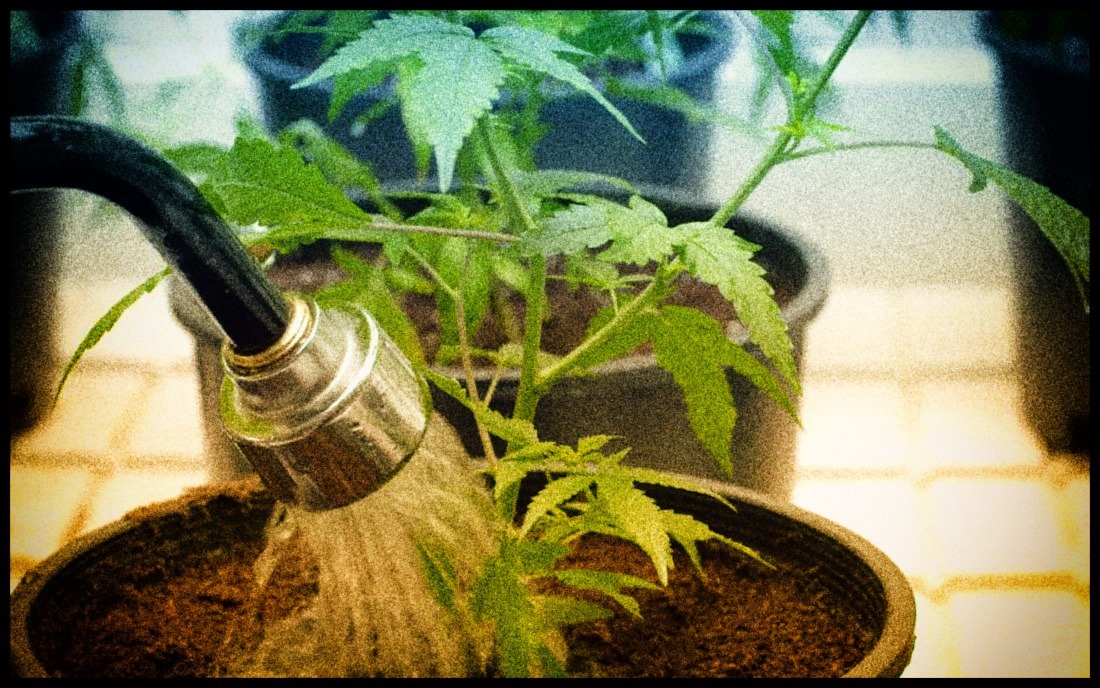Table of Contents [show]
 Flushing weed plants is a method most cultivators use to elevate their buds’ quality. Growers claim that by gently depleting nutrients near to harvest, they end up with flower that tastes better, smells stronger and smokes smoother. In this post, we’ll go through flushing cannabis in detail, including how it works and how to do it in both soil and soilless systems.
Flushing weed plants is a method most cultivators use to elevate their buds’ quality. Growers claim that by gently depleting nutrients near to harvest, they end up with flower that tastes better, smells stronger and smokes smoother. In this post, we’ll go through flushing cannabis in detail, including how it works and how to do it in both soil and soilless systems.
An Overview to Flush Marijuana Plants
Flushing a plant is the process of aggressively removing nutrients from the soil by using plain water. Regularly, a considerable volume of water passes through the soil and is drained away. Any minerals and nutrients in the soil are carried away by the water over time, leaving the soil clean. The goal is to give the plants time to use the nutrients that have already accumulated within them, reducing the final product’s overall nutrient and contaminant load. Flushing is recommended for all types of growers, whether hydro, coco coir, or soil — albeit the time duration for flushing varies based on the medium.
The Ideal Time to You Should Flush Marijuana
Different gardeners flush their plants at various times and in various methods. With multiple harvests, you’ll begin to establish your preferences for how and when to flush your plants. However, there are three common instances in which you could consider flushing:
Pre-Harvest Flush
Flushing is utilized during this step to increase the quality and smoothness of the cannabis. A pre-harvest flush will compel your exotic cannabis seeds to utilize their stored nutrients while avoiding harshness and eliminating excess chlorophyll. If the nutritional reserves are not utilized or broken down, the quality of cannabis buds will suffer. This should be done a week to ten days before harvest and again three days later.
Sudden Modification in the Nutrient Cycle
Cannabis has various nutrient needs depending on its development stage. Cleaning old nutrients is a smart approach to reset soil as a plant moves into a new growth stage.
Nutrient Lockout
Overfeeding a plant nutrient causes it to absorb what is required while the access is in the soil. This causes a buildup of excessive nutrients, a condition known as nutrient lockout. When dealing with a major nutritional imbalance, cleanse the plants and provide a new, well-balanced, modest dosage of nutrients. Pay attention to the specifics; do not simply flush weed because of minor alterations.
What do you Require to Flush Marijuana Plants?
All you truly require is lots of water! The precise technique of when and how much water to flush differs for each grower. Some professional flushers will bring extra equipment to measure the flushed water’s EC (electrical conductivity) or TDS (total dissolved solids). This gives them an indication of how efficient each water flush is. The mineral concentration (or total dissolved solids) in the flushed-out water should reduce with each flush.
How to Effectively Flush Marijuana Plants
Here are common steps to effectively flush marijuana plants:
- Check the pH of the water (tap water is ideal) to ensure it is in the correct range for marijuana plants. The range should be between 6.0 and 6.8 for soil grown.
- Water the plants as you would typically feed them without fertilizers or chemicals. Do not overwater your plants to avoid cannabis deficiencies.
- Repeat the procedure after 15 minutes.
- Use a TDS reader to determine the total dissolved solids and the purity of the water discharge to ensure that the flush was effective. Note: It’s preferable if the water draining from the pots is as similar to the total dissolved solids (TDS) reading of the neutral water you are flushing with as feasible.
- Keep an eye out for excessive yellowing. A plant’s color may fade fast due to the pre-harvest flush. Although some yellowing is typical, harvesting before the leaves on your buds have become yellow is crucial. Once all the leaves have become yellow, your weed plant has matured, and the buds will begin deleting.
- Your plants will be much lighter in color after flushing and will be ready to harvest. Flushing cannabis eliminates debris from a plant’s roots and soil. You should flush your cannabis plants at the beginning or end of the day when they may be misted to minimize transpiration, which can leave your plants overhydrated.
How to Flush Hydroponic Cannabis Plants
It is considerably easier to flush hydroponic plants than to remove nutrients from soil medium. Hydro growers may empty their system and replace it with simple pH-balanced water. Flushing hydroponic plants takes substantially less time. Hydro plants will not be able to get external nutrients once the water source has been cut off. As a result, you will only need to flush plants for two days.
Flush Marijuana Plants – The Outcome
After the bud has been harvested, take the time to cure it to its full potential. A thorough cure will reduce the harshness even more by eliminating elements such as excess chlorophyll. You’ll be surprised at how much of a difference this small effort may make for your buds. Your efforts will be rewarded with the first breath of that silky smooth smoke that touches the back of your throat like honey. This is nature at its most serene. Simply adding water to your cannabis can improve its quality!
When to Avoid Flushing Marijuana Plants
The only time flushing should be avoided is when growing on upgraded organic soil or super soil. This medium is deliberately crafted over time to support beneficial microorganisms, including bacteria and fungi. Flushing has the potential to wash away and harm this fragile biodiversity.
While flushing is a hotly discussed issue among cannabis farmers, it is typically suggested whenever cannabis is grown using concentrated chemical fertilizers. Most producers believe gradually weaning your London Pound Cake strain off its nutrients before harvest can generate a higher quality yield. It is also required when dealing with nutritional imbalances.
Further Reading:
How Is Good Commercial Cannabis Grown?
How To Mainline and Manifold Your Cannabis Plants
The Ideal Light Cycle for Cannabis at Different Growth Stages
Your Ultimate Guide To Cannabis Dispensaries, Headshops, And Collectives




